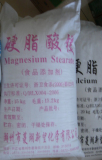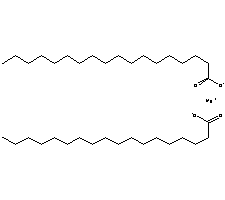| Product description : |
Its major use is in the industry as a lubricant, dusting powder, emulsifier, binder and paint and varnish drier. Magnesium stearate is used in the pharmaceutical drugs in order to bind tablets and make them smooth. It is also a common additive in several foods as it is cheaply available.
When used as an industrial binder, magnesium stearate is always taken in lower concentrations. It is an effective binder and even concentrations as low as 5 to 15%. Higher concentrations can cause compaction problems. As a lubricant, it is added in the powder blend. This is done so that the powder blend does not adhere to the capsule or mould when it becomes compact.
Magnesium stearate is a hydrophobic substance, i.e. it has negative affinity with water. Hence, it can be used in designing firefighting equipment. However, it cannot be used in large proportion as its particles may form an explosive mixture in air. An overdose of magnesium stearate can also give off toxic fumes resulting in asphyxia.
Magnesium stearate has been graded to be a safe chemical compound, with no side effects known. Several foods use magnesium stearate as an additive or preservative. Magnesium stearate is an effective emulsifier used in syrups, ketchups, sauces, etc. It is also used as an anti-caking agent in preparing certain foods. Confectionaries use magnesium stearate for binding candies, etc. Baby cosmetic powder contains magnesium stearate as it provides a softer texture than talcum powder.
Quality USP/BP
Test items Specification
Appearance Fine, light, white powder
Assay (Mg) 4.0-5.0%
Chloride ≤0.25%
Sulfates ≤0.5%
Loss on drying ≤6.0%
Heavy metals ≤0.001%
Arsenic ≤3mg/kg
Stearic acid and palmitic acid ≥90.0%
Stearic aicd ≥40.0%
Organic volatile impurities conform
|

